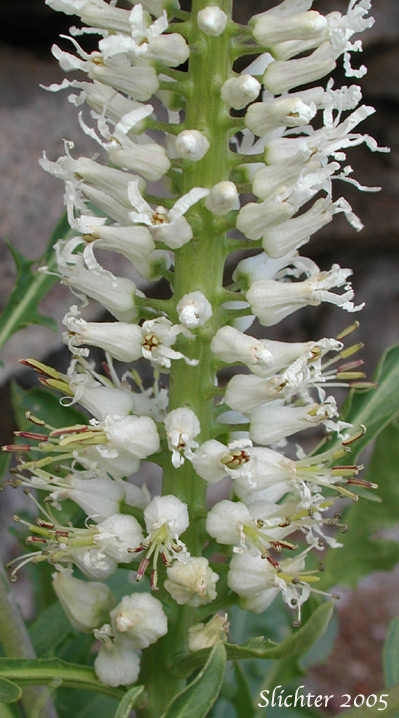 The photo at right shows the densely flowered raceme of thick-leaf
thelypody as seen from the lower elevation rock formations along Washington State
Highway #14 about 5 miles east of John Day Dam............early May, 2005.
The photo at right shows the densely flowered raceme of thick-leaf
thelypody as seen from the lower elevation rock formations along Washington State
Highway #14 about 5 miles east of John Day Dam............early May, 2005.
Thick-leaved thelypody is a freely branched, upright biennial to 25 dm in height. The leaves are both basal and on the stems, with both being fairly thick and fleshy. The basal leaves are deeply lobed and ovate or deltoid-lanceolate in shape. The basal and lower stem leaves range from 10 to 45 cm long. The stem leaves are similar, but become ever-reduced in size, becoming more entire-margined as one proceeds up the stem.
The inflorescence is an elongated raceme, and may make up over one-half the height of the plant. Individual flowers consist of 4 sepals and 4 petals. Depending on the variety, flower color may be white to purplish. The seed capsules are siliques, long and thin, arranged either spreading or somewhat erect, and either straight or slightly arched.
var. laciniatum: White sepals, siliques spreading (4 to 11 cm). Found from eastern Washington to Idaho, south to Nevada and California.
var. streptanthoides: Purple sepals, siliques spreading (6 to 14 cm). Found in central Washington and northern Oregon. See photo at right and below.
var. milleflorum: White sepals, siliques strongly ascending (3 to 6 cm). Found from the Columbia River south to Nevada and east to Idaho.
Thick-leaved thelypody is found in desert regions, often in rock fall or cliff faces. It may commonly be found on the face of road cuts through basalt in the basin country.
Thick-leaved thelypody is found across much of western North America.
In the Columbia River Gorge, variety laciniatum may be found between the elevations of 100'-2900' between Mosier, OR and the eastern end of the Gorge.